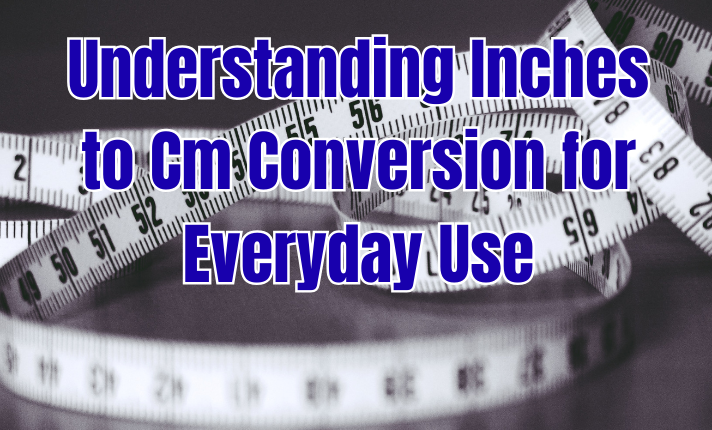Understanding Inches to Cm Conversion for Everyday Use
Understanding Inches to Cm Conversion for Everyday Use

Why Measurement Conversions Matter
In a world where global communication, trade, and lifestyle are deeply interconnected, measurement systems play a vital role. One of the most common conversions people look up is inches to cm. This conversion comes up when buying products online, measuring furniture, tailoring clothes, or even checking personal height. Since countries use different measurement systems—the imperial system in the United States and the metric system in most of the rest of the world—it is essential to understand how to switch between them seamlessly. By mastering this knowledge, you can save time, avoid costly mistakes, and ensure accuracy in daily tasks.
Transitioning from one measurement system to another might feel confusing at first. However, the formula is straightforward, and with consistent use, it becomes second nature. Beyond memorizing the formula, knowing where and when to apply it is equally important.
The Basics of Inches and Centimeters
Before diving into practical examples, let’s start with a clear understanding of what inches and centimeters are. An inch is part of the imperial system of measurement and is widely used in the United States, Canada, and a few other regions. A centimeter, on the other hand, belongs to the metric system, which is the international standard used in most countries across the globe.
To put it into perspective, one inch equals 2.54 centimeters. This fixed relationship makes the conversion process straightforward. If you know the measurement in inches, simply multiply it by 2.54 to get centimeters. Conversely, if you have a measurement in centimeters, dividing it by 2.54 will give you the equivalent in inches.
Understanding this relationship is the foundation of accurate conversions. For example, if you are buying a TV online and its width is given in inches, but your home measurements are in centimeters, converting correctly ensures the product will fit the intended space.
Practical Applications of Inches to Cm Conversion
The need to convert inches to cm arises in countless everyday situations. For instance, people often need this conversion when shopping internationally. Many e-commerce websites list product dimensions in inches, but customers from metric-using countries must convert them to centimeters to compare accurately.
Fashion and tailoring also rely heavily on these conversions. A clothing size chart in the U.S. may use inches for waist and chest measurements, but in Europe or Asia, centimeters are the standard. Misinterpreting these numbers can result in purchasing items that do not fit properly. Similarly, interior design projects, furniture shopping, and DIY home renovations often require precise conversions between the two units.
Travelers encounter this need as well. Height restrictions for rides in theme parks or baggage dimension limits at airports may be listed in inches or centimeters depending on the region. Having a quick method to convert ensures compliance and avoids inconvenience.
The Simple Formula for Conversion
Converting inches to cm involves a direct and easy-to-apply formula. To convert:
-
Inches × 2.54 = Centimeters
For example:
-
10 inches × 2.54 = 25.4 cm
-
25 inches × 2.54 = 63.5 cm
To reverse the process:
-
Centimeters ÷ 2.54 = Inches
Because this formula is straightforward, you can perform it mentally for simple numbers or use a calculator for more precise values. Over time, common conversions may become second nature. For instance, 12 inches equals 30.48 cm, which is exactly one foot in metric terms.
However, for more complex needs, online tools simplify the process even further. Websites such as Whateverconverter provide instant and accurate results without requiring manual calculations. This can be especially useful when dealing with larger projects or frequent conversions.
Advantages of Using Online Conversion Tools
While manual calculations work well for quick checks, online converters make the process faster and more convenient. A tool like Whateverconverter saves time by offering precise conversions instantly. This is particularly valuable for professionals, students, or anyone who regularly switches between the two measurement systems.
Another advantage is accuracy. Human error often creeps into manual calculations, especially when dealing with decimals or multiple conversions at once. Online converters eliminate this risk by providing exact results every time. Furthermore, most tools allow you to convert not only inches to cm but also other units, giving you flexibility across various measurement systems.
Additionally, mobile-friendly platforms ensure that conversions are accessible on the go. Whether you are in a store checking dimensions or working on a project at home, having a reliable digital tool at your fingertips adds convenience and confidence.
Also Read About Biotechnology Engineering Programs
Common Mistakes to Avoid During Conversion
Even with such a simple formula, mistakes can happen. One of the most frequent errors is forgetting the conversion factor of 2.54. Rounding too early is another common issue, as it can create noticeable discrepancies in larger measurements. For example, rounding 2.54 to 2.5 may seem minor, but when multiplying by higher numbers, the difference becomes significant.
Another pitfall is mixing the two systems without converting. For instance, combining measurements in inches with others in centimeters can lead to incorrect results in construction, design, or clothing projects. This is why consistency and double-checking conversions are so important.
Finally, relying on memory instead of verifying with a reliable tool may also create errors. When precision matters, especially in technical work, using an accurate calculator or a trusted website like Whateverconverter ensures dependable outcomes.
Everyday Tips for Accurate Measurements
Applying the knowledge of inches to cm conversion effectively requires a few practical habits. Always keep the 2.54 factor in mind, and practice quick mental conversions for common values. Carrying a tape measure that includes both inches and centimeters can also save time and prevent errors when measuring directly.
For students, creating a small reference chart with frequently used conversions can serve as a handy study aid. Professionals working in construction, tailoring, or design may benefit from bookmarking online converters to streamline their workflow.
It is also helpful to verify important conversions twice, especially if they are part of critical decisions like ordering custom-made furniture or preparing official documents. Accuracy in measurement is often the difference between smooth success and frustrating setbacks.
Conclusion
Understanding how to convert inches to cm is more than just a mathematical exercise—it is a practical life skill. From shopping internationally and tailoring clothes to home improvement and travel, this knowledge applies across numerous areas of daily life. The simple formula, inches × 2.54 = centimeters, provides the foundation, while tools like Whateverconverter offer convenience and reliability.
By applying this knowledge consistently and avoiding common mistakes, you can confidently handle measurement conversions in any situation. Whether for personal use or professional needs, mastering this conversion ensures accuracy, saves time, and reduces errors in everyday tasks.




